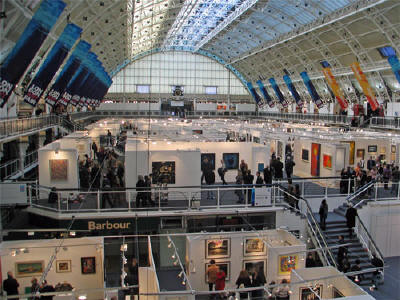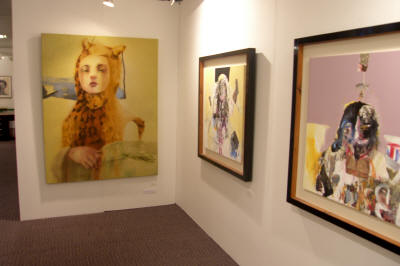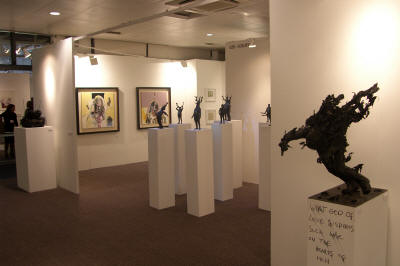|
|
| home | features | exhibitions | interviews | profiles | webprojects | gazetteer | links | archive | forum |
|
Cornish art at the London Art Fair 2008 Henry Garfit Heralded by The Times newspaper as ‘The first major visual art event of the year, London Art Fair in Islington is a mecca for Contemporary and Modern British Art’. Last week saw the twentieth anniversary of the fair and a record 23,000 visitors over the five days with 5,000 people through the doors on Saturday alone.  The
combined forces of the recent success of the more
Contemporary commercial galleries in Cornwall and the last few years
of stellar increases in market values for Modern British art (of which the St Ives artists of the early and mid
Twentieth Century are a major part) means that art made in Cornwall has
never been more in evidence at the London Art Fair than in 2008. The
combined forces of the recent success of the more
Contemporary commercial galleries in Cornwall and the last few years
of stellar increases in market values for Modern British art (of which the St Ives artists of the early and mid
Twentieth Century are a major part) means that art made in Cornwall has
never been more in evidence at the London Art Fair than in 2008.
The Telegraph newspaper has suggested that
‘in its 20-year history, the fair has battled to be international and
purely contemporary, but succumbed to the greater success of Frieze
and Zoo (art fairs) and has now settled for a quieter compromise of
local galleries that show at neither, and others that deal in historic
20th-century British art. The result is a healthy mix of highbrow and
lowbrow to suit all tastes’.
Jonathan Burton, the London Art Fair Director,
has suggested that the above comment is not an entirely accurate
representation of the development of the fair over the past few years;
stating quite rightly that ‘the fair has never been purely
contemporary’ but ‘the fair attracts visitors who are looking for
critically engaged, cutting-edge contemporary work, but equally there
are people who are coming to buy a piece by L. S. Lowry’. However, one
of the main exhibitors at the fair told me that there was certainly
some direct encouragement from the organisers to have a strong showing
of Modern British art perhaps at the expense of more contemporary
work.
 Contemporary
art made in Cornwall was on show at stands taken by familiar Cornish
galleries including: Belgrave, Goldfish and Lemon
Street galleries. There were notable galleries from London and the
provinces which are also significantly skewed towards Contemporary
Cornish art including Edgar Modern, Messum’s, Advanced Graphics,
Caroline Wiseman, Art First and Redfern galleries. Contemporary
art made in Cornwall was on show at stands taken by familiar Cornish
galleries including: Belgrave, Goldfish and Lemon
Street galleries. There were notable galleries from London and the
provinces which are also significantly skewed towards Contemporary
Cornish art including Edgar Modern, Messum’s, Advanced Graphics,
Caroline Wiseman, Art First and Redfern galleries.
Among the highlights of work made by artists
based in Cornwall today was a striking, large canvas entitled
Leopard by Jesse Leroy Smith represented by Goldfish Fine Art,
Penzance. Leroy Smith’s work includes many quite contrasting concerns
such as the dignity with which Rembrandt composes his
figures, the fluidity of Titian, and at the same time something human,
real and yet intangible that is comparable to Marlene Dumas.
Joe Clarke from Goldfish has been showcasing
some of the more challenging work to come out of Cornwall in recent
years by taking a stand (in both senses of the term) at the London Art
Fair since moving his gallery from
 St
Ives to Penzance in 2002. During one of the few quieter moments at the
fair he told me what a positive experience attending the London Art
Fair had been in recent years. In bringing what he calls more
‘outsider’ art from Cornwall to both the fair and the recent
exhibition Goldfish Fine Art held in East London, he has further
affirmed his faith in the quality of a number of the artists coming
out of Cornwall today through the sheer weight of interest they
experienced whilst exhibiting in London. This faith was bolstered by a
number significant sales at the Fair. St
Ives to Penzance in 2002. During one of the few quieter moments at the
fair he told me what a positive experience attending the London Art
Fair had been in recent years. In bringing what he calls more
‘outsider’ art from Cornwall to both the fair and the recent
exhibition Goldfish Fine Art held in East London, he has further
affirmed his faith in the quality of a number of the artists coming
out of Cornwall today through the sheer weight of interest they
experienced whilst exhibiting in London. This faith was bolstered by a
number significant sales at the Fair.
Belgrave
Gallery from St Ives had a successful time at the fair with a number
of works by their stable of artists selling including those by Sarah
Poland, Virginia Bounds and Henrietta Dubrey among others. One of the
strongest works exhibited by a Cornish gallery had to be the rugged
scene in oil entitled Mountain Pass by Sarah Poland. There is
something of the wrestled drawing process of Bomberg or Kossoff in her
landscape paintings which arrests the eye and brings you back time and
again to the best of her pictures.
Again at the higher end of the commercial
spectrum works by the grand old masters of Modern British painting
from Cornwall such as Roger Hilton, Patrick Heron, Sandra Blow and
Terry Frost were selling for gigantic prices at the fair. Richard
Green, the heavy weight of the London market, was selling a 1950’s
Terry Frost for an astonishing £380,000. Beaux Art of London had a
Patrick Heron from the 1970’s on sale for £220,000. Although these
seem like vast prices they are nothing in comparison to the high
prices achieved for works by the European and American contemporaries
of these St Ives artists.
Perhaps the most important thing I noticed
whilst at the fair was that, in my view, whilst recent artist led
exhibitions in Penwith have been supported as a vital forum and
provision of much needed exposure for more exploratory art created in
Cornwall in recent years; there is no question that commercial risks
taken by the likes of the Goldfish, Salt, Belgrave, Lemon Street and
Millennium galleries should also get all the funding and moral support
we can offer them for the part they play in finding locally based
artists a wider audience.
Henry Garfit January 23rd 2008
|
|
|
